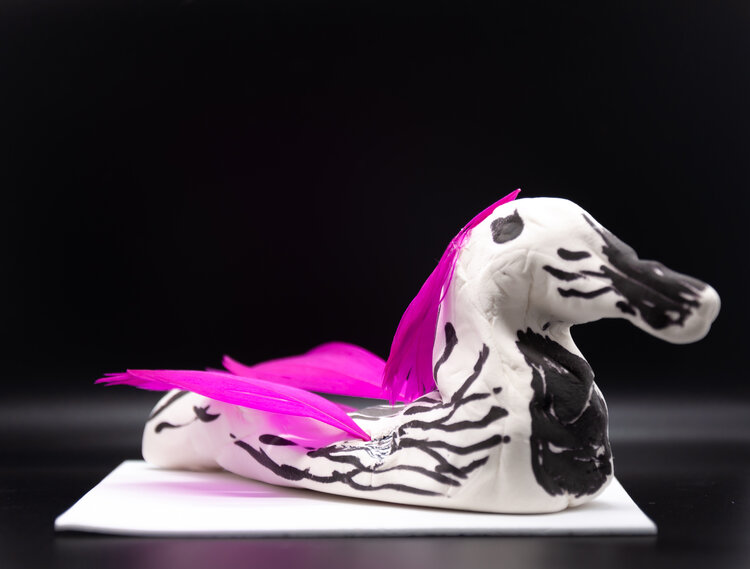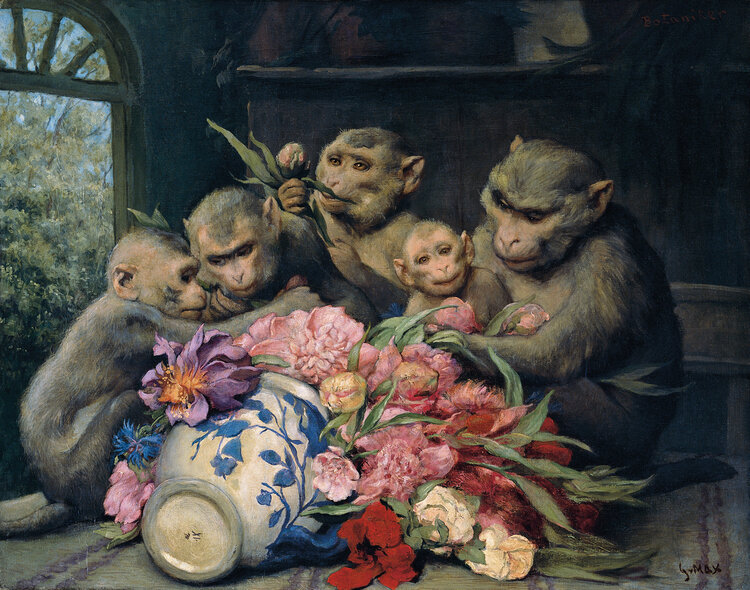This activity accompanies the Art on the Mind: Ten Years of Creative Aging exhibition at the Frye. In Creative Aging, art-making projects are designed to emphasize creative decision-making and the tactile experience of working with different art mediums. Such projects build self-confidence and foster a sense of play for people living with dementia. This activity allows a care partner to encourage creative exploration and experimentation with a person living with dementia and provides an opportunity for both to discuss and make art.

Anne O’Leary. Untitled, 2019. Sculpted Model Magic clay with marker ink, feathers, and beads on foam. 2 x 6 x 2 1⁄2 in. Photo: Heather Ratcliff.
For this activity, you’ll look closely at a painting in the Frye Art Museum’s Founding Collection and create a sculpture of an animal in response to it. Download the activity card.
MATERIALS
-
Crayola Model Magic or Play-Doh (or any soft clay)
-
Markers
-
Pipe cleaners or craft wire
-
Sequins, buttons, beads, feathers, or other embellishments
-
Glue (optional)
-
Cardboard or heavy paper to use as a working station and base for the sculpture

Gabriel von Max. Botaniker (The Botanists), ca. 1900-1915. Oil on canvas. 25 x 31 3/4 in. Frye Art Museum, Founding Collection, Gift of Charles and Emma Frye, 1952.117. Photo: Eduardo Calderón
ACTIVITY INSTRUCTIONS
-
First, take a few quiet moments to look at the image of Botaniker by Gabriel von Max above. Then use the following open-ended questions for a deeper discussion about it.
-
What’s going on in this painting?
-
What do you notice first in this work of art?
-
Look at the background of this image. Where might this scene be taking place? What do you see that makes you say that?
-
Close your eyes and imagine you’re in this painting. What do you hear? See? Smell? Feel?
-
Let’s look at the monkeys’ expressions. How are they feeling?
-
Why do you think the artist chose to capture this moment?
-
What do you notice now that you didn’t see before?
-
-
After some conversation, encourage your artist to use that inspiration to create a sculpture of an animal. The animal could be real or imagined—there are no rules!
-
Let the artist experiment with the Model Magic or Play-Doh in their hands. How might you change the clay with your hands? By rolling, pinching, or folding?
-
Your artist can add details to the sculpture by using markers and/or embellishments.
-
When the sculpture is complete, look at it from all sides and discuss what you’ve created together.
-
What do you see?
-
What do you like best about the sculpture?
-
How did it feel to work with clay?
-
TIPS FOR LOOKING AT ARTWORK
-
Focus on a theme if you’re discussing multiple artworks.
-
Always begin by looking together in silence.
-
Ask open-ended questions.
-
Allow for response time so that everyone can think about what they would like to say.
BONUS
You can try making your own clay from scratch in order to create sculptures by following the video demonstration below.
To explore the exhibition, you can take a virtual tour of Art on the Mind, where you can see the artworks in the exhibition, read the wall texts and labels, and view photographs of the exhibition galleries.